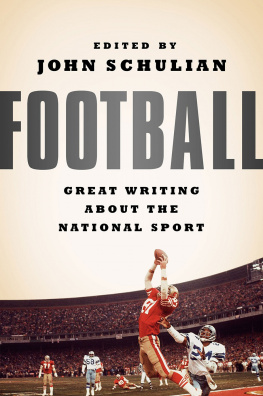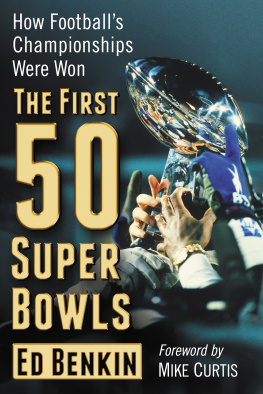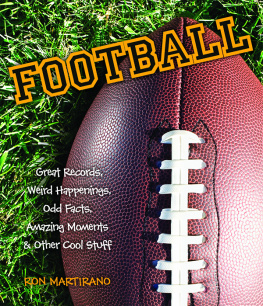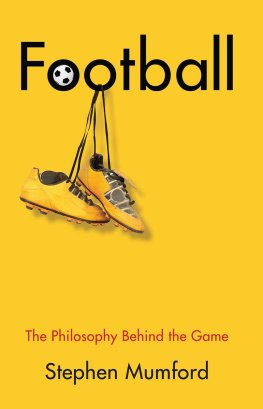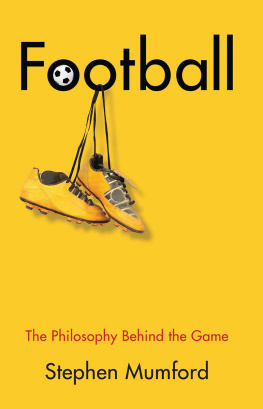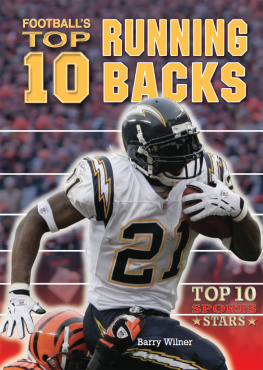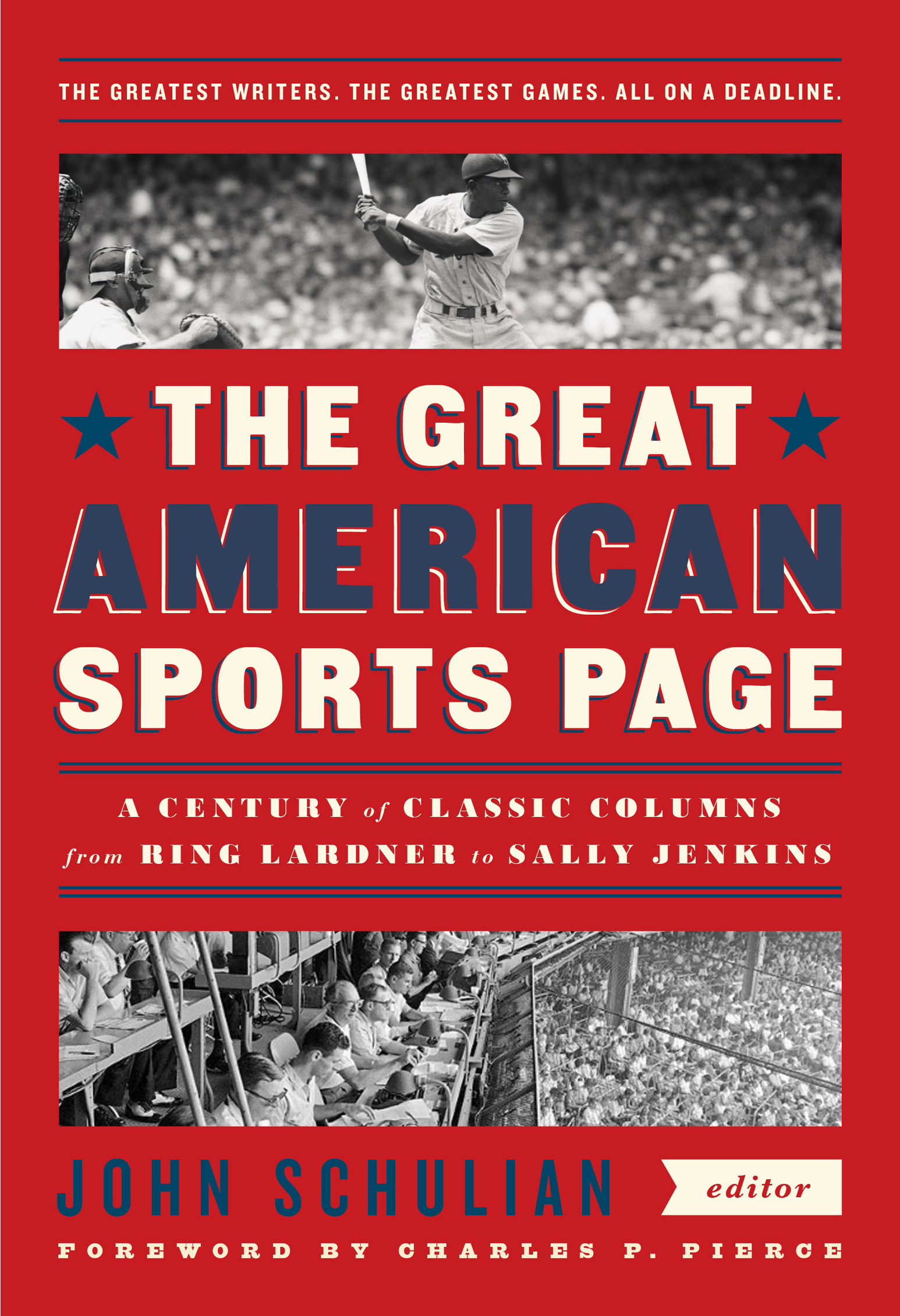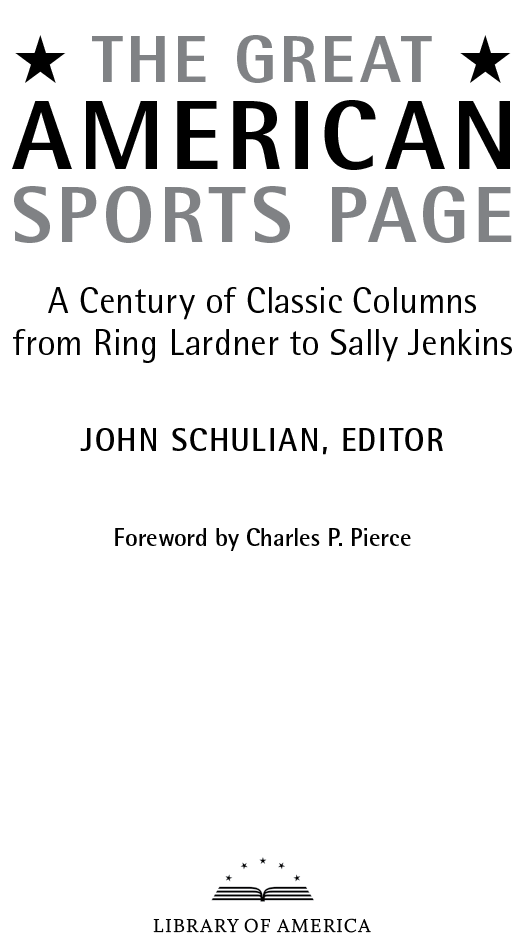
THE GREAT AMERICAN SPORTS PAGE
Foreword, introduction, headnotes, and volume compilation copyright 2019 by
Literary Classics of the United States, Inc., New York, N.Y.
All rights reserved.
Published in the United States by Library of America.
www.loa.org
No part of this book may be reproduced in any manner whatsoever
without the permission of the publisher, except in the case of brief
quotations embodied in critical articles and reviews.
Some of the material in this volume is reprinted with the permission of holders
of copyright and publishing rights. Acknowledgments are on page .
Distributed to the trade in the United States
by Penguin Random House Inc. and in Canada
by Penguin Random House Canada Ltd.
eISBN 9781598536133

Contents

Foreword
by Charles P. Pierce
O N SATURDAY , October 25, 1986, I wrote the same story four times with four different endings, and all between the hours of 11 P . M . and 1 A . M . on an ice-fingered night in the borough of Queens, New York City. The Boston Red Sox and the New York Mets were playing the sixth game of that years World Series. The Red Sox had a 32 lead in games, and they were leading 20 when the Mets came to bat in the bottom of the fifth inning. That was the first time I wrote the story.
At the time, I was a sidebar/feature writer for the Boston Herald, a tabloid owned by an Australian pirate named Rupert Murdoch, whose enthusiasm in his American properties were sports and political coverage that checked in somewhere to the starboard side of Vlad the Impaler. I was a sportswriter so I was lucky that my soul remained relatively intact. In the fifth inning of that game, I was almost all the way through with my story. I was drowning my prospective reader in lore; Boston had not won a World Series sinceall together now1918, but the whole Curse of the Bambino arsenal of nostalgia had not yet been fully weaponized. (That, as we shall see, would come later that night.) I also was going heavy on the lore because not a helluva lot had happened and I had a deadline looming. And Saturday deadlines for the Sunday newspaper were the most merciless of all.
This was a joke we used to tell at the Herald when we all got together down at J. J. Foleys, one of the last great cop-and-newspaper bars. The newspaper was located directly across the Massachusetts Turnpike from Bostons Chinatown neighborhood. Naturally, the print deadlines were fashioned to get the papers to the more distant precincts first. So the joke was that anything submitted after midnight would have to be written in Chinese because only the newspaper circulated in the three blocks around the paper would contain the story. This is a joke that gets funnier in retrospect than it was as October 25, 1986, became October 26, 1986, and the Mets tied the damn game in the bottom of the fifth.
Back into the copy I went, thinning out the lore, changing the emphasis so as to make it easier for me to change the emphasis if the Red Sox blew this game and New York forced a seventh game. The Red Sox scored a run in the seventh. I tinkered a little more. The Mets tied it in their half of the eighth. I reverse-engineered my tinkering back to what it had been before. The two teams went into extra innings. I tinkered more heavily, actually constructing dummy ledes that I thought could cover any outcome. This proved to be a very bad call indeed.
In the top of the tenth inning, Bostons Dave Henderson, about whom Id already written when hed cracked a pennant-saving home run against the California Angels, parked one into the left field stands. I began to write again about how Henderson was now the unlikeliest hero of all, having saved two postseason series with dramatic home runs. I was still writing this when Boston scratched another run across to lead 53. We were now well into those hours in which the conventional Herald wisdom had it that I should have been writing in Mandarin. But, then, Bill Bucknerand all the ridiculous events leading up to Bill Bucknerunfolded, and I had to start all over again, writing about a world-historical debacle with fifteen minutes or so left and the Deadline Muse sitting on my shoulder, whispering things like, Dont forget that Bob Stanley was out there looking like the bystander at a car bombing. To this day, I dont remember what I wrote, but I do remember thinking while enjoying a postgame beer or three that Id never been happier or more satisfied in my work.
A week or so later, of course, I came down with bronchitis that lasted until Thanksgiving.
In Much Ado About Nothing, Shakespeares Beatrice turns down the heroic Don Pedro by telling him, No, my lord, unless I might have another for working-days: your Grace is too costly to wear every day. The Deadline Muse is a muse for working days. She is not as costly as the Magazine Muse or the Book Muse or the Novel Muse. She is always overworked, and always underloved, except in retrospect, when all of we suitors come to miss her insistence that we do our best work in the least amount of time and talk of her fondly in her absence.
As time and technology passed, I noticed that the Deadline Muse was being called upon to work harder than before. One of the great attractions of newspapering of any sort was that it was one of the few occupations that required a great amount of hanging around. Hanging around crime scenes and courthouses. Hanging around legislative chambers and press rooms, and ballparks and press boxes. In times like that, the Deadline Muse got time to rest so that she would be strong and true when called upon in extremis. Now, though, in this era in which we are not reporters writing stories but, rather, content-producers producing content across many platforms, nobody gets any time off. Hanging around has been replaced by tweeting out into the world every new and tiny thing that floats by as though it were Lindy landing in Paris. The Deadline Muse is worn out, and the occupation of daily sportswriting is exhausting itself in tandem.
I somehow have transitioned to the point where nearly all my work takes place online now and, often, I am asked how I can produce what is said to be a great deal of contentLord, how I hate that goddamn wordin a short space of time. I tell them, well, once there was a night in Queens, and when I get to that part of the story, in my minds eye I can see the Deadline Muse again, as young as she used to be, and I hear her calling me to work again.

Introduction
By John Schulian
T HE AMERICAN sports page was more than a section of the newspaper when newspapers monitored the heartbeat of everyday life. It was the inspiration for a twentieth-century ritual now turned sepia. Factory workers wanted scores in the morning and race results in the afternoon. Subway riders and living-room readers ignored the ink that stained their fingers to find out who was in first place. The lot of them could have moved on to the front pages wars, political shenanigans and crime sprees after a minute or two. But whether they were college professors or fresh off the boat, adults or children, men or women, they stayed for the writing that was good enough to spare the sports page from the bottom of a birdcage. Some dared call it art.


